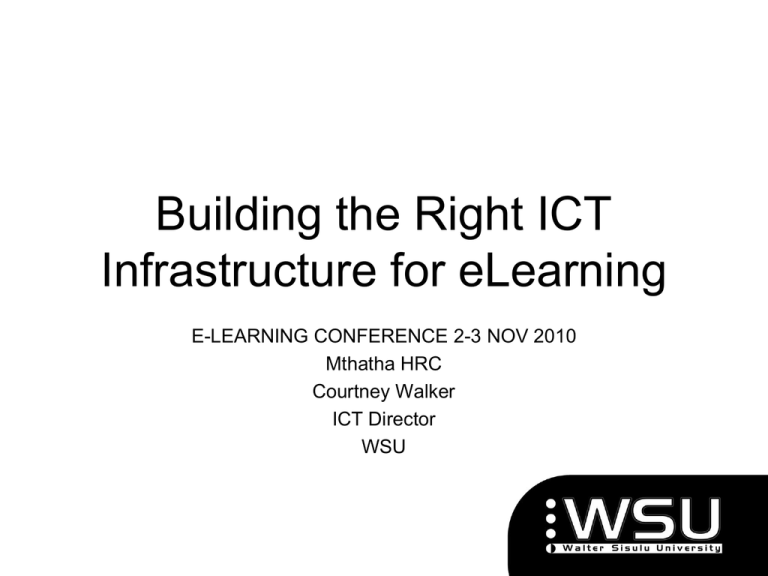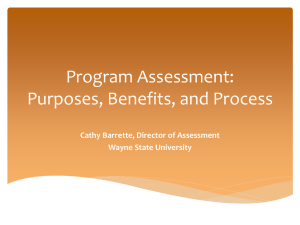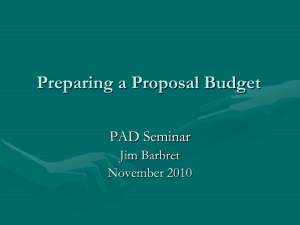Building the right IT infrastructure for e
advertisement

Building the Right ICT Infrastructure for eLearning E-LEARNING CONFERENCE 2-3 NOV 2010 Mthatha HRC Courtney Walker ICT Director WSU Agenda • • • • • • eLearning Requirements Enterprise Video Teleconferencing Bandwidth Issues Performance Issues Current Developments Future Developments eLearning Requirements • A New dimension – Interactive and live distance teaching using video and rich presentations for small groups – Simultaneous distance teaching sessions – streaming of live presentations to large student groups – On-demand viewing of saved presentations – Integration between eLearning and business systems to facilitate Single Sign On, sharing of data, Email, SMS integration – Accessing services securely over the Internet (outside of WSU) Objective eLearning must minimize operational cost whilst allowing students to get the best educational experience Enterprise Video Teleconferencing MCU An enterprise Video Conferencing System consists of at least one central MCU and several endpoints. Conference Room MCU is: Multipoint Control Unit or Multipoint Conference Unit Office Endpoint is the device that allows each participant to engage with the video teleconference session. It can be a boardroom system, PC or Mobile phone. Each endpoint forms a virtual link to the MCU. PC System Enterprise MCU • • • • • Allows many users to connect to a conference Allows many simultaneous video conferencing sessions Support Video, Voice and Computer Presentations Accommodates various video qualities-HD, SD etc Uses the IP Network thus allowing access from anywhere and using any device • Supports legacy networks such as ISDN (WSU is using currently ISDN provided by Telkom) • Integrates with Video Streaming Server to: – Stream live presentations to large audience – Record presentations – Provide On-demand Presentations Reality • Quality Video Teleconferencing requires huge Bandwidth. – – – – Cost of Bandwidth depends on size HD = 2Mbps to up 16Mbps SD = 512Kbps Low quality video =128Kbps or less (currently used by WSU) • Need to be smart about the design and development of the WSU Network so as to minimize cost and maximize performance – Will the solution reduce the operational expenditure for WSU? – Should we use offsite service such as Skype or WebEx? Internet Bandwidth Rates Services Mobile-normal (Per MB) Mobile-VOIP (Per MB) TENET (Per Month per Mbps) Rates 1.00 10.00 5,000.00 1. Mobile’s charges are normally based on usage in Megabytes (MB) 2. Mobile Providers charge a higher usage fee for Skype and other VOIP services. 3. TENET and other fixed site Internet providers typically charge a fixed monthly fee for a specific data speed. Cost of using 3G for VOIP and Video Teleconferencing For a One Hour Video Conference assuming a video quality of 512Kbps. This amounts to 3700 Megabyte of Data. The cost per user is: Normal Mobile Rate VOIP Mobile Rate ZAR 3,700.00 ZAR 37,000.00 3G card is not suitable for VOIP or Video Teleconferencing unless facilitated through the ICT Department??? WSU Network PDM NMD CLE •WSU Network consists of Sites interconnected by Private Data Links provided by Telkom, Neotel and a private Wireless MAN in East London •The WSU Network has an Internet Breakout Point that connects to TENET Should weInternet use offsite or onsite•The new 3G solution with Vodacom connects MCU? our 3G users directly to Internet Link Wireless MAN IBIKA CHI the WSU network. Whittlesea Private Data Links Off site MCU 1. Offsite server is provided by an external company somewhere on the internet Off site MCU 2. Each endpoint must have a virtual link that goes through the internet to the server Internet Link Internet Virtual link WSU Network 3. 20 endpoints require 20 virtual links through the Internet Link On Site MCU 1. server is located at WSU at the main data centre Virtual link 2. Endpoints will be on the WSU Network except for a small percentage on the Internet. Internet Link WSU Network Internet Remote User on the Internet Cost Breakdown Onsite Offsite Server ZAR 1,000,000.00 ZAR Internet bandwidth ZAR ZAR 9,000,000.00 Total ZAR 1,000,000.00 - ZAR - 9,000,000.00 Cost comparison for three years for 100 endpoints assuming: •Each endpoint requires 512Kbps. Internet Bandwidth Required for offsite server is approximately 50Mbps for 100 endpoints. •cost of every Mbps to be R 5,000.00 per month •Zero cost of offsite Server (such as Skype) •Zero Internet Bandwidth for Onsite Server •Private Network requirements remain the same for both onsite & offsite Overhead Cost Of Onsite Meetings Assuming Avg Return Distance to meeting Avg persons per meeting Percentage who travel Avg Time on Road per person per meeting Cost and hours lost 250 40 75% 3 Total Cost for the Year Total Man Hours on travelling for the year 4,875,000.00 9000 Other factors Mileage Cost (Per Km) 2.5 Meal per person 150 •Fatigue due to travelling Accommodation Per Person 800 •Risk of travelling Number of Meeting per year 100 •Cost of expert lecturers at all sites Performance Issues • Performance can be guaranteed through two technologies – Quality of Service (QOS). With Onsite MCU the quality of the video teleconference can be enforced on the Private Network. Internet operates on a best effort so QOS cannot be enforced. – WAN acceleration. Tremendously reduces bandwidth through compression and elimination of redundant data. • Example: suppose 50 persons at IBIKA needs to receive the same unicast 512kbps video feed from NMD. Without WAN acceleration the required bandwidth on the WAN link would be 25Mbps. With WAN acceleration the required bandwidth would only be 512Kbps. Current Development • Order has been approved for: – An enterprise MCU • located at College Street • allows up to 96 endpoints • Six new boardroom systems at to be located at NMD, IBIKA, Masibulele, East London and Potsdam • Integration of current Video Conferencing systems • Allow users to connect with their desktops and laptops • Up to 8 concurrent sessions at NMD (10Mbps link) • Up to 4 concurrent sessions at Potsdam (4Mbps) • Up to 4 concurrent sessions each at Whittlesea and IBIKA (5Mbps by February) – Video Streaming Server that • Allows capturing of Live events anywhere within WSU • Allows streaming of Presentations everywhere • Allows publishing of Presentations on the Internet – QOS and WAN acceleration will be configured – Telephone and Fax solutions – Cost 3,000,000.00 – Expected Date –February 2011 Current Developments-2 • Server & Storage Project to be completed by January 2011 – Integration between Blackboard, GroupWise and ITS – Allow students and staff to save work remotely on servers – Access files from anywhere – Move towards thin-client computing – Desktop management, endpoint security • Enforce Desktop Policy • Ensure Anti-virus and Windows are updated regularly • Eliminate Rogue computers Future • SANREN coming to WSU’s remote sites – RFP will be issued by CSIR for extension of SANREN to WSU remote sites – Gov’t will spend 50Million to build broadband infrastructure in the rural area. – Faster and cheaper bandwidth – More video teleconferencing sessions – Better quality video teleconferencing Thank You







